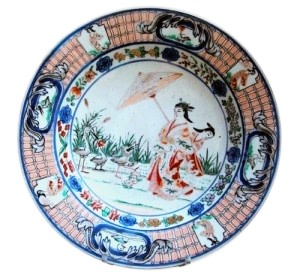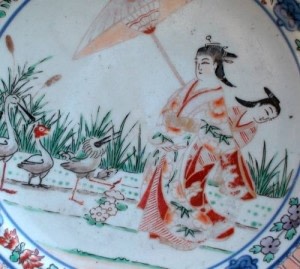Decorated in coloured enamels and underglaze blue highlighted in gold with 'La Dame au Parasol' after the design by the Dutch draughtsman Cornelius Pronk, an attendant (kamuro) holding a parasol raised above a courtesan (oiran) looking down at three water birds, a fourth disappearing into a pond fringed with bulrushes, the well with rose-headed sprays divided by prunus, peony, chrysanthemums and berried foliage, the border reserved with alternate panels of ladies and attendants and the four birds depicted in the central panel, the larger panels within feathery cartouches, all featured on a ground of graduated cell pattern, the underside with iron-red pencilled insects.
Literature
First introduced by the Chinese, 'La Dame au Parasol' was one of several designs commissioned by the Dutch East India Company from Cornelius Pronk between 1734 and 1737. The designs also appear in the famille rose palette and as Chinese Imari. The Dutch (or private individuals) also approached the Japanese to produce sample plates decorated with 'La Dame au Parasol' in famille rose and Arita blue and white. For a long discussion of the whole group of Cornelius Pronk designs, and the way in which they were ordered and received by the Hoge Regering at the VOC base in Batavia, see C.P.A. Jorg, Pronk Porcelain, pp. 51 and 99 -102.. According to Soame Jenyns two of the birds represented are the ruff and the spoonbill and are both natives of Holland.
Cf C.P.A. Jorg, Pronk Porcelain (Porcelain after designs by Cornelis Pronk), Exhibition Catalogue, Groninger Museum April-June 1980, nos. 32 and 35;
Soame Jenyns, Japanese Porcelain, pl. 46a.
See also an interesting discussion on these designs in Porcelain for Palaces, The fashion for Japan in Europe 1650 -1750, Ayers, Impey & Mallett (with contributions by Anthony du Boulay and Lawrence Smith), Oriental Ceramic Society, London 1990, page 114, plate 70.
'Officially the order from Japan was abandoned in 1740 on economic grounds, but it seems likely that it was continued by private traders.
In Europe, the decoration was taken up by Dutch enamellers on oriental porcelain or Delft wares and later, at various porcelain factories.'




